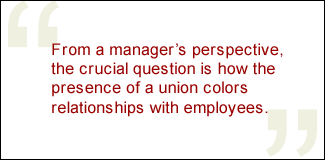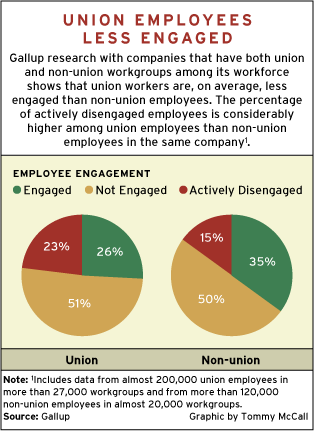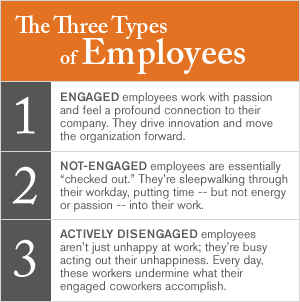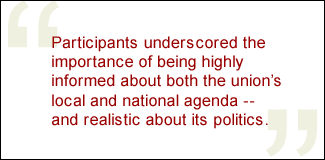If management takes a more active role in engaging its unionized workers, does that reduce the need for organized labor? Will unions view systematic efforts by management to keep employees happy and fulfilled as an attempt to undermine their own support? If so, how can companies defuse the situation by working with unions to support employee engagement?
 |
Executives and managers tackled these and other questions at a recent Gallup roundtable discussion on engaging union employees, which took place in Washington, D.C. The 25 participants came from companies in a variety of industries, but all either had a large proportion of union employees or must account for the influence of unions in their labor market.
Public attitudes toward unions
James K. Harter, Ph.D., Gallup's chief scientist for workplace management and well-being, got the event started with a review of recent Gallup data on labor unions. He stated that Americans are less likely to belong to labor unions than they were 50 years ago. In the 1940s and 1950s, about one in six Americans told Gallup pollsters they belonged to a union; today the number is about one in ten. Unions still enjoy public support, although Americans' likelihood to say they approve of them has also declined somewhat in recent decades. Currently, 58% of Americans say they approve of unions, while 33% disapprove. A slight majority, 52%, say they've tended to sympathize with unions in labor disputes over the last two or three years, while 34% say they've sympathized with the companies.
From a manager's perspective, the crucial question is how the presence of a union colors his or her relationships with employees. Gallup's data suggest that union employees are, on average, less engaged than non-union employees. As the graphic indicates, the percentage of actively disengaged employees is considerably higher among unionized than non-unionized employees in the same company. (See graphics "Union Employees Less Engaged" and "The Three Types of Employees.")
 |
In some cases, the sizeable differences may be because union employees tend to have different roles within the company than other employees. For example, at a power utility, the electricians may be unionized but not the administrative staff. However, the roundtable participants agreed that union membership itself can contribute to an "us versus them" mentality that can also diminish employees' sense of rapport with their companies. One participant, who said her company's approach was to partner with unions, said that "There are more adversarial relationships in some areas, and those are reflected in our employee engagement scores."
In discussing Gallup's data with roundtable participants, Harter stressed two other points. The first, gleaned from a Gallup Poll of the U.S. working population conducted in October 2005, is that unionized employees are more likely to say they will stay with their companies throughout their careers, but they're slightly less likely to recommend their companies to family and friends as a place to work. In other words, the sense of security their union affiliation gives them may encourage unionized employees to stick around -- but that feeling doesn't translate into a greater emotional attachment to their jobs.
The second point is that the relationship between engagement and productivity is equal in union and non-union environments. Gallup's research with companies suggests that it may be harder to engage employees in a union environment, but engagement has just as profound a relationship to productivity in union and non-union environments.
Key insights
 |
The averages notwithstanding, Harter notes there are many unionized workgroups that rank highly in Gallup's database of workplace engagement studies. Though it can be a challenge to build strong emotional connections with unionized employees, many companies do it. The roundtable discussions produced a number of useful insights into how they pull it off:
Make the engagement-building process open, inclusive, and non-threatening. If union employees perceive an employee engagement survey and subsequent impact planning processes as secretive and threatening rather than constructive, the effort is essentially doomed from the start, the roundtable group said. Employees are less likely to provide unbiased responses, and the union is more likely to do whatever it can to keep its members from participating.
When a government agency decided to focus on engaging its frontline employees as part of a broader effort to raise customer satisfaction, one of the first issues it needed to address was to ensure that the process was open and non-threatening. "[The union's] biggest concern was that the surveys not be used to promote a witch hunt," said an analyst attending the roundtable. "They wanted to know it was part of a learning environment, that it was non-threatening." Once that orientation was clearly established, the union threw its weight behind the agency's efforts to improve engagement.
Involve union officials in the survey and resulting change processes. The same government agency went on to win union officials' full support by offering them input in the development process of the employee engagement survey. Beyond the survey's core engagement questions, additional items were negotiated between the agency and the union so both had a stake in the survey's outcome. The survey has been a success, the agency's representative said; the resulting impact plans have boosted employee engagement, and customer satisfaction is slowly but steadily rising. (See "You've Gotten Employee Feedback. Now What?" in the "See Also" area on this page.)
Several of the roundtable participants also mentioned that it's important to emphasize that the company is not trying to undermine the union's role. Attempts to raise engagement in a union workplace should include close communication with union representatives, and, ideally, their active support is enlisted.
As one participant stated, "That all sounds nice," but union officials are often highly skeptical of, and sometimes downright hostile to, employee surveys of any kind. How can companies overcome that resistance? One manager suggested that safety concerns can be a good initial connecting point. Gallup research shows a strong relationship between employee engagement and workplace safety in a variety of settings. "The relationship between engagement and [workplace] safety is hard to argue with," the manager said. "It's an easy starting place for agreement, which can then flow into other areas."
But participants also sounded a note of caution against allowing the union to hijack the engagement program for the union's own purposes. They underscored the importance of being highly informed about both the union's local and national agenda -- and realistic about its politics. Though it's seldom easy, one participant said, managers who understand union leaders' point of view may be able to use employee engagement as a rallying point to build trust between the company, its employees, and the union.
 |
Use action planning to develop new lines of communication with employees. One reason union-management relations can be contentious is that it's hard to get everyone to agree on what's best for workers. Several of the roundtable participants described how their companies have used engagement efforts as opportunities to find new ways to let their employees speak for themselves.
One of the roundtable participants is an executive at a large service-based company in an industry where employee burnout and turnover tend to be very high. Yet the organization maintains high levels of employee engagement and, in fact, has been able to halt several union attempts to organize employees at its facilities. The company's leadership recognizes that employee engagement is particularly critical in their industry, the executive said. Managers conduct regular action planning with all employees to address their facilities' engagement levels.
What's more, executive-level leaders use that action-planning process as an opportunity to meet directly with groups of hourly employees in different locations. The resulting dialogue gives leaders powerful insights and employees a strong sense of connection to the company. As some participants said, being able to voice their opinions about important matters like health benefits and retirement planning can create valuable champions of engagement among frontline managers and employees. "Listening is important to them," said the service industry executive, "and the outcome is important to us."
Perhaps most importantly, as one participant said, using engagement programs can open up new lines of communication and increase the flow of creative ideas that serve to keep the organization vital. That participant, a manager at a large power utility, described special Intranet sites designed to enable all employees to express their opinions and maintain a dialogue with the company's leadership. "The more engaged groups are submitting more ideas," she said. "And more of those ideas are being implemented. We've found that engagement fosters innovation throughout the organization."
Recognize that unions can help the company increase employee engagement. The presence of labor unions can pose a challenge to companies that intend to raise employee engagement, but it may also present opportunities. When union-management partnerships can come together to focus on aspects of engagement, such as growth and development opportunities, all employees may benefit.
Best of all, the devotion some unions inspire in their members can serve as a model for companies seeking to achieve a similar connection with employees -- particularly, as one roundtable participant said, when it comes to communicating a clear, consistent purpose. "People want to belong to something they can believe in," the participant said. "The organization needs to talk about purpose, mission, and values -- and then align them with behaviors. That's fundamental to engagement, and historically, unions have done better at that [than businesses]."